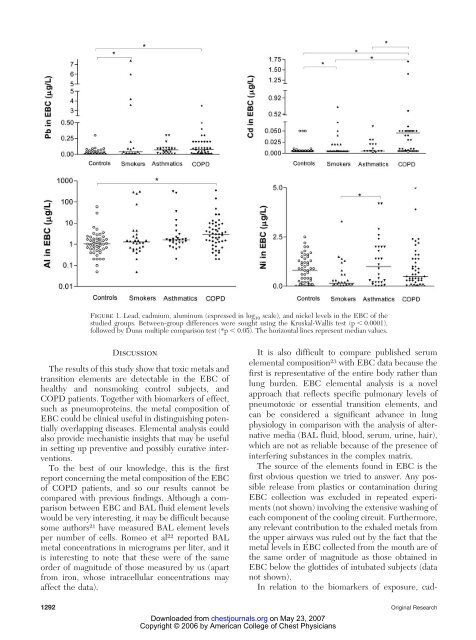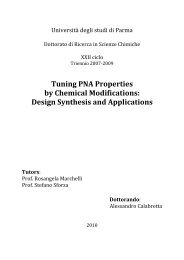Create successful ePaper yourself
Turn your PDF publications into a flip-book with our unique Google optimized e-Paper software.
Figure 1. Lead, cadmium, aluminum (expressed in log 10 scale), and nickel levels in the EBC of the<br />
studied groups. Between-group differences were sought using the Kruskal-Wallis test (p 0.0001),<br />
followed by Dunn multiple comparison test (*p 0.05). The horizontal lines represent median values.<br />
Discussion<br />
The results of this study show that toxic metals and<br />
transition elements are detectable in the EBC of<br />
healthy and nonsmoking control subjects, and<br />
COPD patients. Together with biomarkers of effect,<br />
such as pneumoproteins, the metal composition of<br />
EBC could be clinical useful in distinguishing potentially<br />
overlapping diseases. Elemental analysis could<br />
also provide mechanistic insights that may be useful<br />
in setting up preventive and possibly curative interventions.<br />
To the best of our knowledge, this is the first<br />
report concerning the metal composition of the EBC<br />
of COPD patients, and so our results cannot be<br />
compared with previous findings. Although a comparison<br />
between EBC and BAL fluid element levels<br />
would be very interesting, it may be difficult because<br />
some authors 21 have measured BAL element levels<br />
per number of cells. Romeo et al 22 reported BAL<br />
metal concentrations in micrograms per liter, and it<br />
is interesting to note that these were of the same<br />
order of magnitude of those measured by us (apart<br />
from iron, whose intracellular concentrations may<br />
affect the data).<br />
It is also difficult to compare published serum<br />
elemental composition 23 with EBC data because the<br />
first is representative of the entire body rather than<br />
lung burden. EBC elemental analysis is a novel<br />
approach that reflects specific pulmonary levels of<br />
pneumotoxic or essential transition elements, and<br />
can be considered a significant advance in lung<br />
physiology in comparison with the analysis of alternative<br />
media (BAL fluid, blood, serum, urine, hair),<br />
which are not as reliable because of the presence of<br />
interfering substances in the complex matrix.<br />
The source of the elements found in EBC is the<br />
first obvious question we tried to answer. Any possible<br />
release from plastics or contamination during<br />
EBC collection was excluded in repeated experiments<br />
(not shown) involving the extensive washing of<br />
each component of the cooling circuit. Furthermore,<br />
any relevant contribution to the exhaled metals from<br />
the upper airways was ruled out by the fact that the<br />
metal levels in EBC collected from the mouth are of<br />
the same order of magnitude as those obtained in<br />
EBC below the glottides of intubated subjects (data<br />
not shown).<br />
In relation to the biomarkers of exposure, cad-<br />
1292 Original Research<br />
Downloaded from<br />
chestjournals.org on May 23, 2007<br />
Copyright © 2006 by American College of Chest Physicians
















